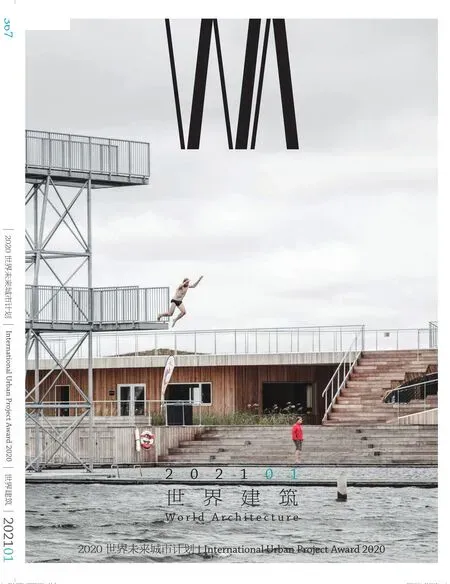运河探索中心,布鲁塞尔,比利时
建筑设计:波格丹与范·布罗克建筑事务所

1 外景/Exterior view
布鲁塞尔正在重新为自己定位。结合基于城市结构和社会经济现实的地方总体规划,以及由欧洲、区域和地方治理所提供的大量公共财政援助,大都市区制定了雄心勃勃的全球战略。在这一背景下,布鲁塞尔运河地区的发展必将为这座城市提供新的支柱,增强该市的社会和地方凝聚力。过去,运河是布鲁塞尔与比利时的主要海港安特卫普,以及煤矿和冶金业的发源地夏勒罗瓦之间的重要连接。然而,这座历史名城在经历了战后经济恢复以及向服务型经济的转型后,在运河沿岸留下了废弃的工业遗产和脆弱的社会经济结构。而今,在城市结构上,这个过去被忽视地区的位置被新的区域交通网络改变了。运河西岸处于多极布鲁塞尔大都市区的中心位置。这些社区面临着许多社会经济挑战:这里聚集了大量拥有移民背景的不同种族的年轻人,职业技能不足,失业率极高,住房老旧,对医疗设施、教育和文化设施或绿地空间的需求日益增加。
尽管如此,运河地区仍为工业棕地的恢复提供了许多机会。在过去几十年间,通过各种私人和公共举措,其潜能已充分展露。依据总体规划,“南港创新运河”是以复兴运河为宗旨的城市项目中较大的一个。它得益于重要的公共投资,包括地方市政当局、布鲁塞尔首都区和欧洲区域发展基金,这是一个旨在减少区域不平衡的结构性欧洲基金制度。它还包括运河探索中心(简称COOP)项目,即把一座始于1903年的旧厂房改造成社会文化设施,包括展览中心、创新造船厂和与之相连的中小型企业孵化器。
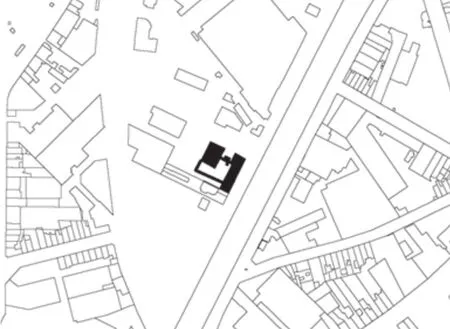
2 总平面/Site plan
COOP面临的特殊挑战是如何满足当地对文化和社会可持续性的需求以及对破碎的城市结构的创新性再利用。在这种情况下,COOP创造了附加的社会价值。我们所要实现的城市更新远不只是建筑遗产保护,它还是项目策划本身的巨大挑战。在孵化器旁边,造船厂将传统上内河航道船只和驳船的设计及制造方法与创新方法相结合,进而成为行业培训和振兴的机构。通过大量的媒体库、展览、工作坊和其他活动等不同层面的策划,展览中心给出了对该社区过去和未来遗产的解读。因此,我们的任务是设计高品质和创新的建筑,从而使合适的规划、区位和资源在社会层面上产生积极影响—使建筑成为贫困地区经济恢复的引擎和驱动力。
COOP的项目经理约瑟·梅内德斯强调了建筑文脉与其意图之间密不可分的联系:
“南港项目意图将该区的物质遗产和非物质遗产都放置在设施中心,将遗产保护与更新作为社会、文化和经济的附加值,这或许是它的一个独特之处。我们的目标只是强调学习潜力、吸引力,以及遗产作为动力之源所承载的诗意和惊羡。遗产在这里是没有任何限制的。
每天,在COOP项目的设计和交流过程中,该地区和厂房的大量遗产都被视为灵感来源——它的感召力和魅力是我们最好的资产。展览中心的公众性和教育目的,以及孵化器更多的财务目标,都要求项目能够随时间推移承载这种物质的和非物质的遗产,以使大多数人都能直接获得它。
项目旨在通过吸引新的活动来振兴布鲁塞尔这一地区的经济生活。请不要误会:将生产活动和生活在社区遗产中的市民的居住相结合并非异端。相反,这一做法已被证明能有效增加社会附加值并保持经济平衡。
有种方法在房地产开发商教科书中无法找到但是经验证明仍然是有效的:公共伙伴关系、本地参与者、独特的建筑项目、经济活动和社会功能的结合、对房地产营销的不信任以及在网站上寻找真实的人际关系都是其中的一部分!” (王惠 译)
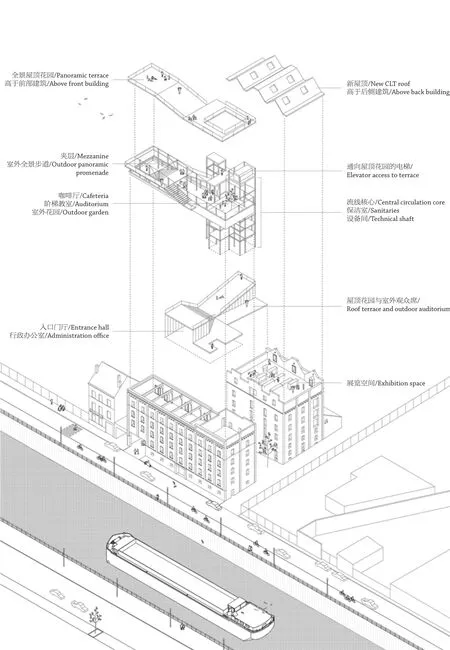
3 分解轴测/Exploded isometry
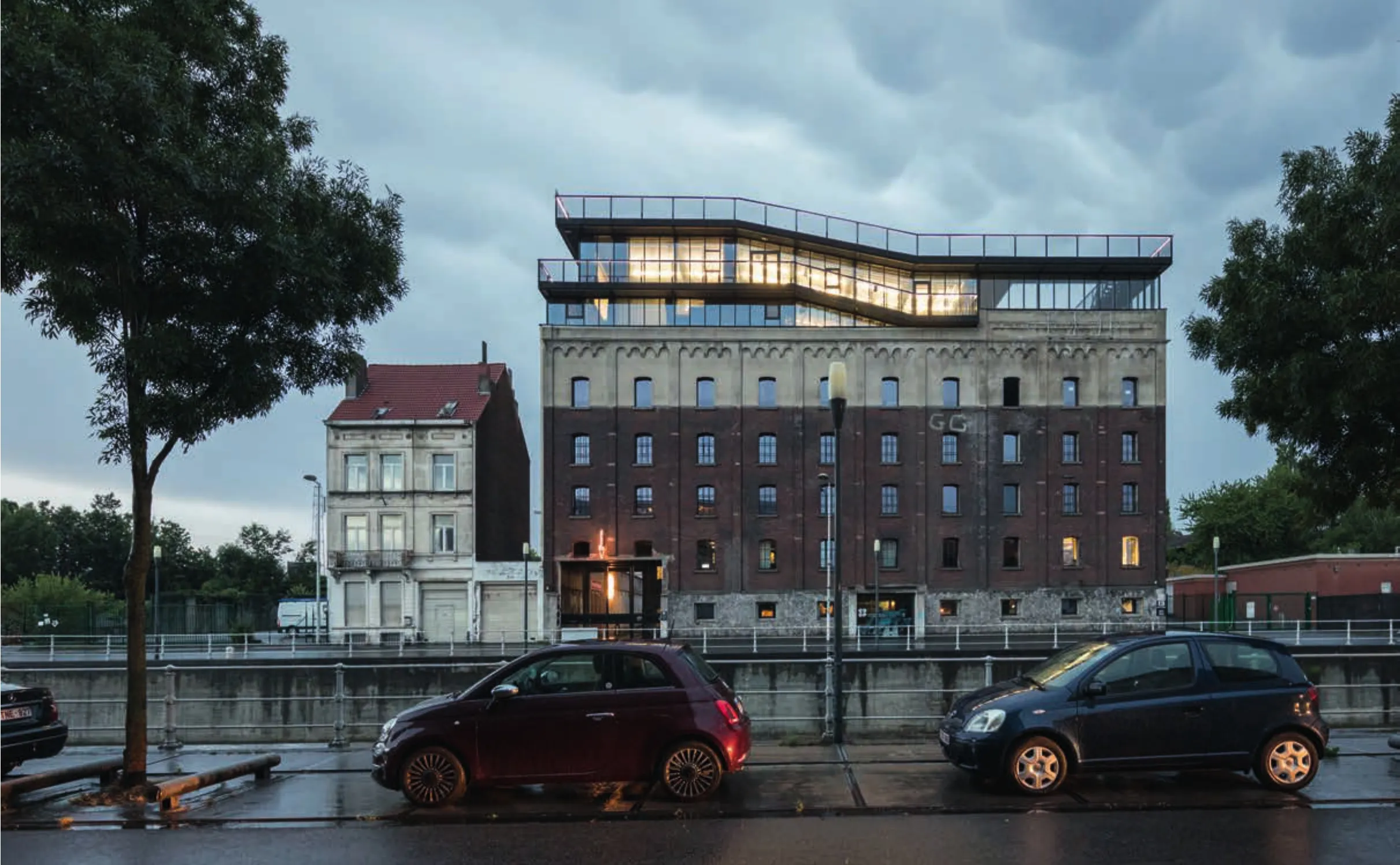
4 夜景立面/Night view of façade
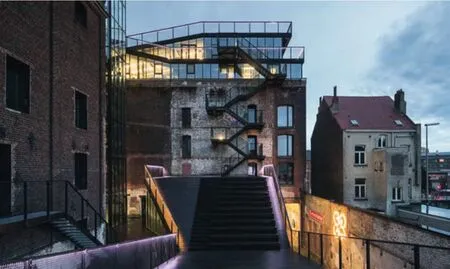
5 夜景/Night view
Brussels is rethinking and rede fining its whole territory. An ambitious global strategy for the metropolitan region is combined with local master plans anchored in the urban fabric and the socioeconomic reality and extensive public subsidies carried by European, regional and local governance.In this context, the development of the area of the Canal of Brussels is foreseen to provide a new backbone for the city, enhancing both the social and the territorial cohesion of the city. In the past,the Canal was linking Brussels to Antwerp, the main sea harbour in Belgium, and Charleroi, the cradle of coal mines and metallurgical industries.However, the post-war redevelopment of the historical city and a shift towards a service-based economy has left behind an abandoned industrial heritage and a fragile socio-economic fabric along the Canal. Today, a new regional transportation network proposes a shift in the positioning of this previously neglected area within the city structure. The western banks of the Canal are now strategically located in the heart of a multipolar Brussels metropolitan area. Many socioeconomic challenges are concentrated in these neighbourhoods: a dense young and heterogeneous population of immigrant background, a low level of basic quali fications, a substantially high rate of unemployment, an ageing housing stock, increasing needs in healthcare facilities, educational and cultural equipment or green spaces.
Still, the Canal area offers many opportunities of brownfield redevelopment and already revealed its potential over the last decades through various private and public initiatives. Within the overall master plan, "Port-Sud Innovative Canal" is one of the greater urban projects zones identified to carry the redevelopment of the Canal. It benefits from major public investments, both from the local municipalities, the Brussels capital Region, and the FEDER - a structural European funding system aiming to reduce regional imbalance. And it includes COOP - the reconversion of an old mill dating back from 1903 into a socio-cultural equipment including an incubator for Small & Medium Entreprises linked with an interpretation centre and an innovation shipyard.
The peculiar challenges of COOP are the local needs for cultural and social sustainability and an innovative reuse of a poorly integrated urban fabric.In that context, COOP generates an added social value. The urban renewal we aim at goes beyond the preservation of a built heritage, it constitutes the essential challenge of the programme itself.Next to the incubator, the shipyard associates traditional and innovative methods for the design and manufacturing of boats and barges for inland waterways, as a frame for professional training and reinsertion. The interpretation centre offers a reading of the past and future heritage of the neighbourhood through an extensive library of media and a multifaceted programming of exhibitions, workshops and other events. Therefore,we believe that our mission here was to propose a qualitative and innovative architecture in order to enable the right programme, the right location and the right resources to generate a beneficial impact on a social level - to allow the building to become an engine, a driving force in the redevelopment of an underprivileged area.
José Menendez, manager of COOP, highlights the in-dissociable link between the context of the building and its purpose:
"One of the singularities of the project Port-Sud probably lays in the will to place both the tangible and intangible heritage of the area in the centre of the apparatus, to consider its preservation and renewal as a source of social, cultural and economic added value. We are aiming at nothing but to stress the learning potential, the attractiveness and the sense of poetry and wonderment carried by our heritage as the seeds of far-sighted dynamics.Heritage here has no constraint.
Every day, in the process of designing and communicating the COOP project, the dense and intense legacy of the area and the mill is asserted as a breeding ground - whose evocative character and ability to fascinate are our best asset. Both the civic and educational purposes of the InterpretationCentre and the more financial goals of the Incubator require to be able to carry this material and immaterial heritage through time, to make it accessible to the majority, seamlessly.
The agenda rooted in the project is to dynamise the economic life of this zone of Brussels,by attracting new activities. And let there be no mistake: there is no heresia in believing in the combination of working activities and the accommodation of a population deeply embedded in its neighbourhood heritage. On the contrary, the recipe has proven to be fruitful both for its social added value and economic balance it provides.
There is a way that can't be found in the real estate developer textbooks, but that is still valid by the means of experience: public partnerships, local actors, unique architectural projects, combination of economic activities and social functions, a sense of distrust towards real estate's extravaganza and the search for authentic human relationships on the site are a few of its ingredients!"
项目信息/Credits and Data
地点/Location: Quai Fernand Demets 23, 1070, Brussels
客户/Client: Anderlecht Moulart
主持建筑师/Principal Architects: BOGDAN & VAN BROECK
设计团队/Design Team: Oana Bogdan, Leo Van Broeck,Heidi Bosteels, Maxime Czvek, M. Lefeber, Thomas Rigby,Lourenço Van Innis, S. Vander Goten
结构工程/Structural Engineers: NEY & partners
技术工程/Technical Engineers: CES
景观工程/Scenography: Håkan Harrysson - Svensk Idé
顾问/Consultant: Hendrik Vanmolkot (Cultural expert)
总承建/General Contractor: CFE
场地面积/Site Area: 1926 m²
占地面积/Building Foot Print: 1273 m²
基底面积/Built Area: 新建面积/New constructed floor area:1063 m²; 改建面积/Renovated floor area: 4036 m²
总建筑面积/Total Floor Area: 5099 m²
造价/Cost: 640万欧元不含税/6,400,000 EUR excl. vat and fees
设计时间/Design Period: 2011-2016
施工时间/Construction Period: 2014.06-2016.09
摄影/Photos: Laurian Ghinitoiu (fig.1,4-6), BOGDAN &VAN BROECK ( fig.10-13)


13 城市景观/Townscape
评委评语
李存东:如何评价一座旧厂房的改造是否成功?COOP为我们提供了多因素的参考。除了建筑外观的改变带给运河新的活力象征以外,内部展览中心对过去和未来的解读宣示了该项目的文化意味,此外,中小型企业孵化器的策划试图解决一定的社会问题,并对这一项目的经济平衡给予支持。从更大范围看,该项目是城市复兴计划的一部分,需要平衡公益投入的愿望、社区居民的诉求以及城市发展的需要。过程中的探索和努力也是该项目值得关注的一部分。
Jury Statement
LI Cundong: How to evaluate the success of a renovation of an old factory? COOP provides us with a multifactorial reference. In addition to the change in the exterior of the building, which brings a new symbol of vitality to the canal, the translation of the past and the future in the interior interpretation centre asserts the cultural signi ficance of the project. The planning of the incubator also attempts to address certain social issues and support the economic balance of the project. On a larger scale, the project is part of an urban regeneration plan that requires the balance between the desire for public investment, the aspirations of community residents,and the needs of urban development. The exploration and effort involved in the process is also a noteworthy part of the project. (Translated by PANG Lingbo)

